UNO Magazine: Hope in the Darkness
Holocaust survivor and artist, Samuel Bak, offers lessons on moving forward.
- published: 2023/06/08
- contact: Robyn Murray
- email: unonews@unomaha.edu
- search keywords:
- UNO Magazine
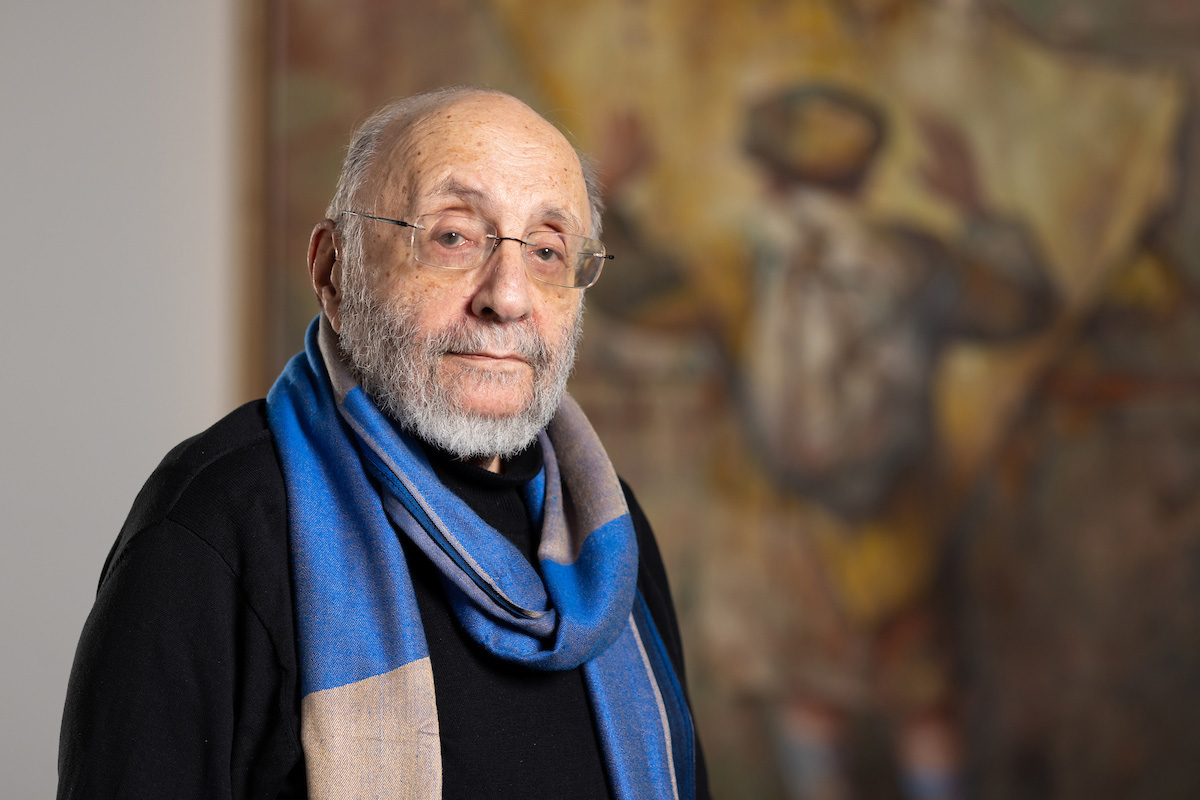
From the Spring 2023 UNO Magazine
The boy stands with his hands in the air, despair in his eyes. His body, scarred and pitted in stone, seems to emerge from a gravestone riddled with bullet holes. He holds a sling shot in his hand, a doomed defense against crushing force.
The painting, Icon of Loss, For the Many Davids, by Samuel Bak, captures and transforms an iconic image from the Holocaust of a young boy with his hands up, being marched to his death or another wartime horror. The original image, which became known as “Warsaw boy,” was captured by a Nazi photographer trying to document his efficiency as an executioner.
As Bak writes in his memoir, “Painted in Words,” the boy could have been him: “the same cap, same outgrown coat, same short pants.”
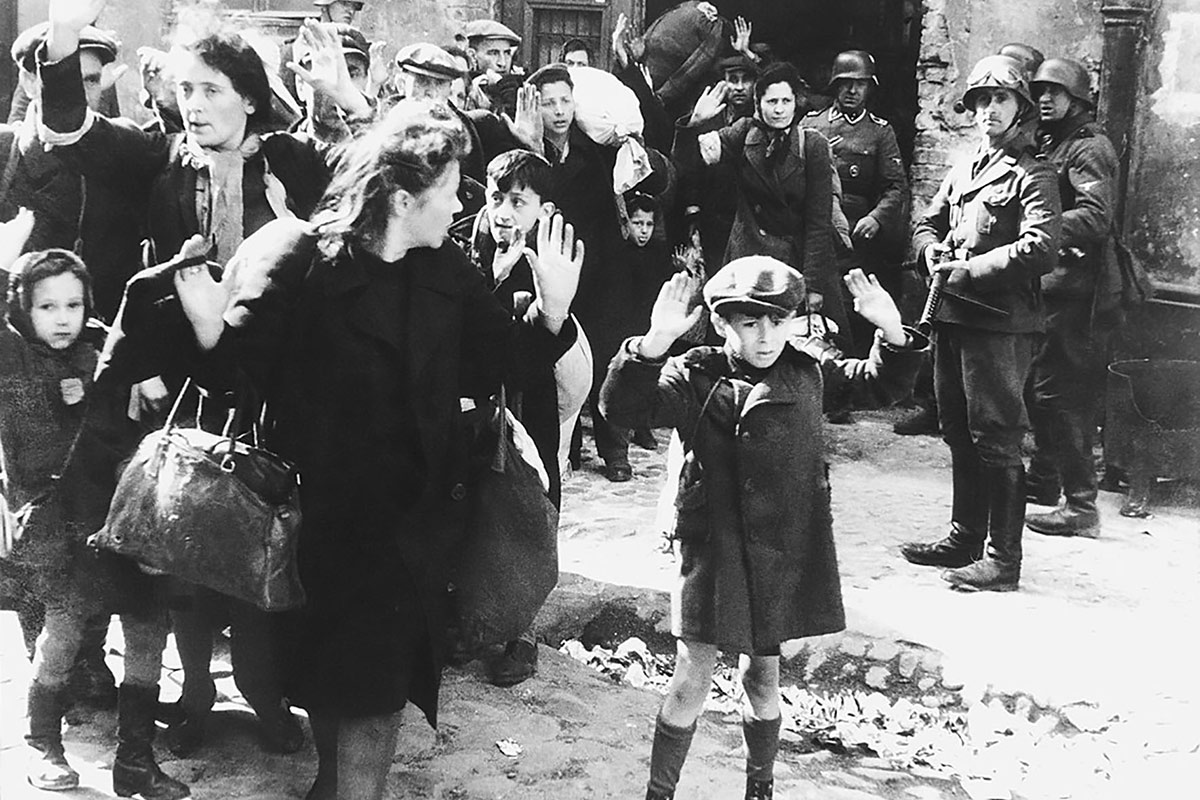
Warsaw Ghetto Uprising (Poland) – Photo from Jürgen Stroop Report to Heinrich Himmler from May 1943. One of the most iconic pictures of World War II.
Bak, a Lithuanian-American artist, was born in 1933 in Vilna, Poland, a city whose population of 60,000 Jews was annihilated during the Holocaust. By some accounts, as few as 2,700 Jews survived. Among them were Bak and his mother, who spent much of World War II hidden in a convent, aided by a Catholic nun. Bak was six years old at the start of the war. He has clear memories of his early years, nurtured by parents and grandparents who he describes lovingly in his memoir. By age 11, Bak had lost his entire extended family, including his father, who was murdered days before Vilna’s liberation.
“The Holocaust was a laboratory of human behavior,” Bak said in a recent interview. “It taught us to see that in each one of us was the best and the worst. People were capable of things that they never imagined about themselves, for the better and worse. I mean, people were able to suffocate a child, so the child wouldn’t cry in the hiding [place]. And other people were able to put their life at risk to save other people.”
As a child, Bak was already a prolific painter. His first exhibit, at age nine, was organized by two poets he befriended while living in the Vilna Ghetto. Today, his work is featured in galleries around the world, and his vast collection — he reportedly can be working on 120 paintings simultaneously — is considered a seminal representation of the Holocaust and Jewish experience. The Warsaw boy is featured in dozens of Bak’s paintings, which are rich with symbolism and iconography. Clocks without hands, chess pieces, pears and stacks of books are all used frequently. Some are icons of Jewish lore, others are universal images that depict vulnerability, loss and order thrown into chaos.
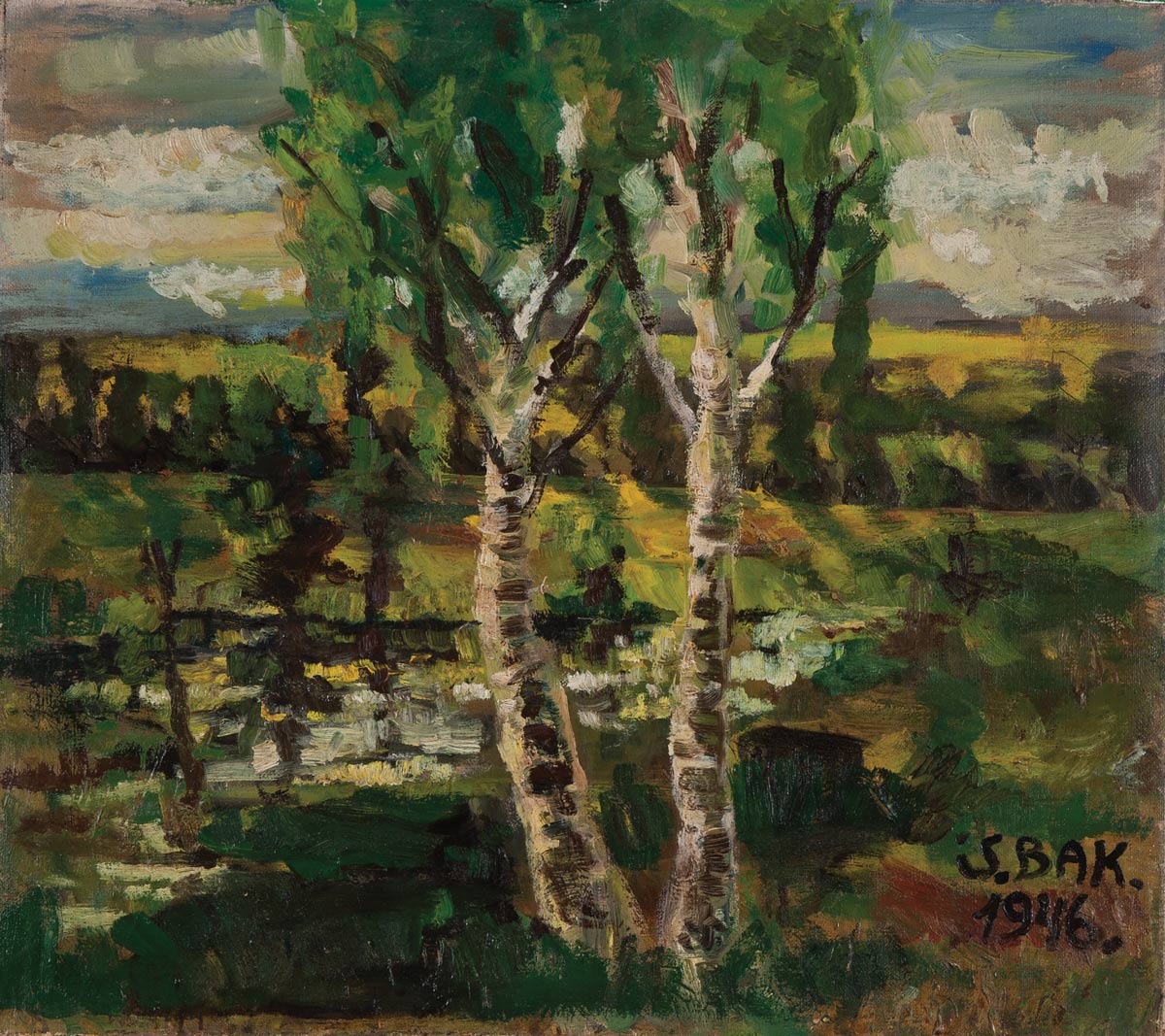
My First, 1947; Oil on linen; 23.75 x 27.25”; Courtesy of the artist and Samuel Bak Museum: The Learning Center.
Bak’s work is particularly valuable as a teaching tool. His use of symbolism provides the viewer with a means to absorb difficult subject matter. “They are windows into an alternate reality,” Bak said. “And in that reality, what they see are remains of a world that once existed, and remains that have tried to reconstruct, somehow. The broken is always remaining, and it is remaining to tell us about the circumstances that allowed it to happen.”
Mark Celinscak, executive director of the Sam & Frances Fried Holocaust & Genocide Academy at UNO, has long recognized the value of Bak’s work in education.
“The art of Samuel Bak helps teachers and students make important connections between history and the moral choices they confront in their own lives,” Celinscak said. “It offers a framework and a vocabulary for analyzing the meaning and responsibility of citizenship and the tools to recognize bigotry and indifference in their own worlds.”
Celinscak had incorporated Bak’s work into his curricula for years when he began a quest to bring the artist and his work to Omaha. Celinscak reached out to colleagues in the School of the Arts and the College of Education, Health and Human Sciences and began a collaborative effort that resulted in a 70-piece exhibit of Bak’s work. Witness: The Art of Samuel Bak drew approximately 4,500 visitors, including more than 2,000 middle and high school students, over its three-month run in 2019. A teaching curriculum was developed in conjunction with the exhibit, and Bak attended classes as a guest speaker. UNO’s Goldstein Center for Human Rights also hosted a symposium to discuss art and human rights issues.
Moved by the response to his exhibit, Bak decided to gift a massive collection of his work — 512 pieces that span several decades — to UNO. And in February, the Samuel Bak Museum: The Learning Center opened with a curated exhibit of his work and a series of events that welcomed 600 students, faculty and community members.
The museum is currently housed in a temporary space in Aksarben Village, but the goal is to find a permanent home for Bak’s collection on campus. It’s an ambition that will require significant private investment and is being led by a veteran of development, public administration and museum leadership, Hillary Nather-Detisch, who was hired as executive director in July 2022.
“The vision is a space where we talk about social justice, human rights, the Holocaust and genocide,” Nather-Detisch said. “It’s a conversation starter.”
Nather-Detisch said the museum will bring people together to tackle hard questions about the nature of humanity, our shared history and our present. She envisions it as a versatile tool for educators and hopes to partner with a cross-section of institutions to bring students from local schools and universities to view Bak’s collection.
“Every student will come in with their own individual experience,” Nather-Detisch said. “An international student coming from Afghanistan, who has experienced wars and violence, is going to have a very different perspective than a student who came from North Platte. But hopefully, they both come to the same realization about what Sam’s trying to portray.”
Nather-Detisch imagines a collaborative model similar to the Barbara Weitz Community Engagement Center, which fosters cooperation by housing numerous nonprofits that serve the greater community. She said the museum already has student workers from disciplines as varied as art, history, computer science and engineering.
Bak said he felt that collaboration and the commitment of UNO to both the arts and human rights when he first visited Omaha for the Witness exhibit. He recalls meeting former UNO Chancellor Jeffrey Gold, who gave him a tour of the Chihuly Sanctuary, a glass installation by artist Dale Chihuly that is the cornerstone of the Fred & Pamela Buffett Cancer Center Healing Arts Program.
“I suddenly realized how seriously art is being considered and believed in as something which is really part of our life,” Bak said, “so it can enrich us and can elevate us somehow spiritually.”
Bak’s art elevates and inspires despite the darkness of its subject matter. Several of his pieces feature letters from the word “hope” in various forms amid depictions of destruction.
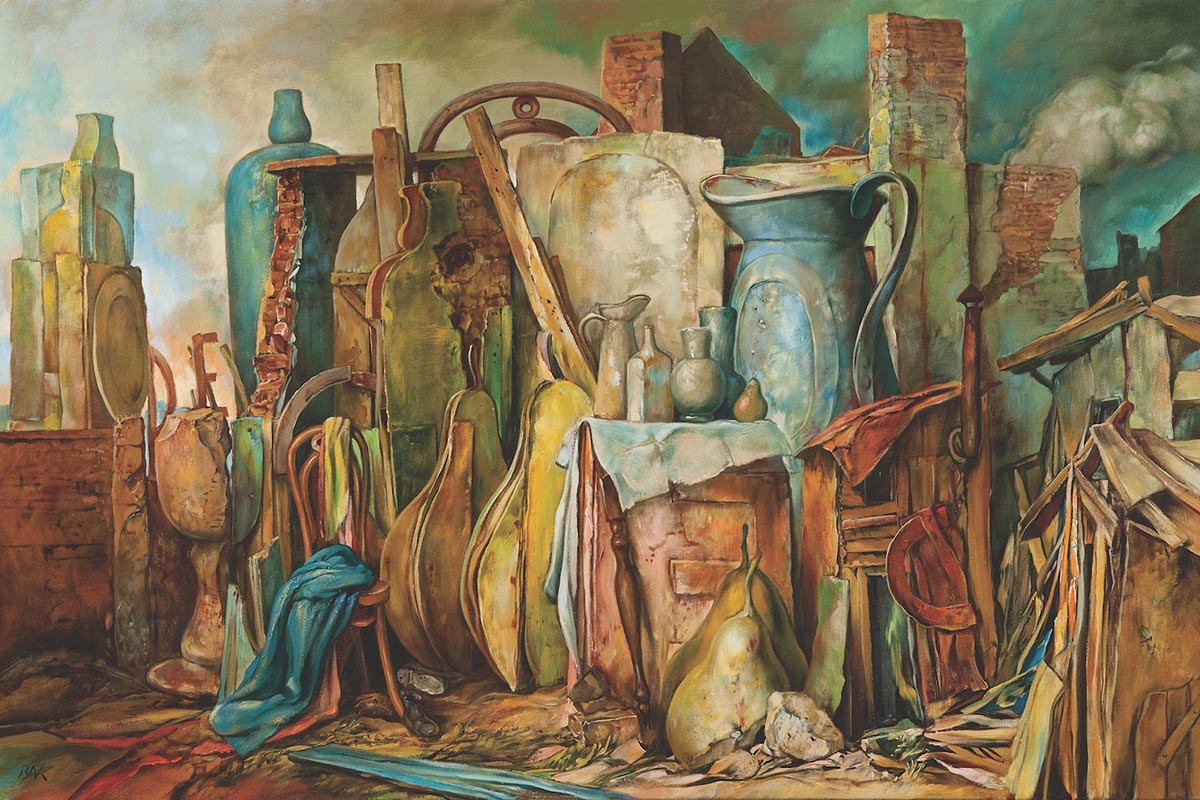
After the Oncome of Peace, 2013; Oil on canvas; 24 x 36”; Courtesy of the artist and Samuel Bak Museum: The Learning Center.
“I as a young man lived among many survivors, and their stories and their sheer resilience have touched me very much,” Bak said. “So, my paintings are not only about the time of the horror, but also about the time of what has followed, about the rebuilding.”
Nather-Detisch said viewers must absorb both the darkness and light in Bak’s work to fully appreciate it.
“Sam’s work is an expression, yes, of his experience in the Holocaust, but it’s really about moving forward and how, for him, it’s a process,” said Nather-Detisch. “That’s how he’s processing everything that he experienced. It’s about hope … it’s about how do we move forward?”
That is one question Samuel Bak Museum: The Learning Center will encourage students and community members to wrestle with. Addressing it requires not only understanding our collective history but recognizing its present echoes. The ongoing war in Ukraine, as Bak says, “has something of Hitler’s virus in it.”
“My aspiration is to make people wonder and question all the assumptions that they have,” Bak said, “and try to understand the world in which we live.”
Bak has shared his work with numerous educational programs around the world and said he is determined to connect with young people, in whom he sees hope for a better future.
“I still believe that young people can make an enormous change,” Bak said. “There are millions of kids that have seen my paintings that know something about my story, that maybe are today more careful in their decisions about what kind of society they would like to live in.”
At 89, Bak continues to paint prolifically, charged with a sense of urgency to tell his story. “I shall go on painting more and more,” he wrote in an essay for Facing History and Ourselves. “As long as I keep breathing.”
Bak once said he wishes he could paint “one million of these Warsaw boys, for the number of children who were murdered.” But the dozens he has painted live on, forever with their hands raised, for all those lost – broken but still present, haunting but hopeful in their resilience. As long as Bak’s paintings survive, so do they, each child is given new life through the eyes of those who see them and remember their story.
Learning From the Past for the Future
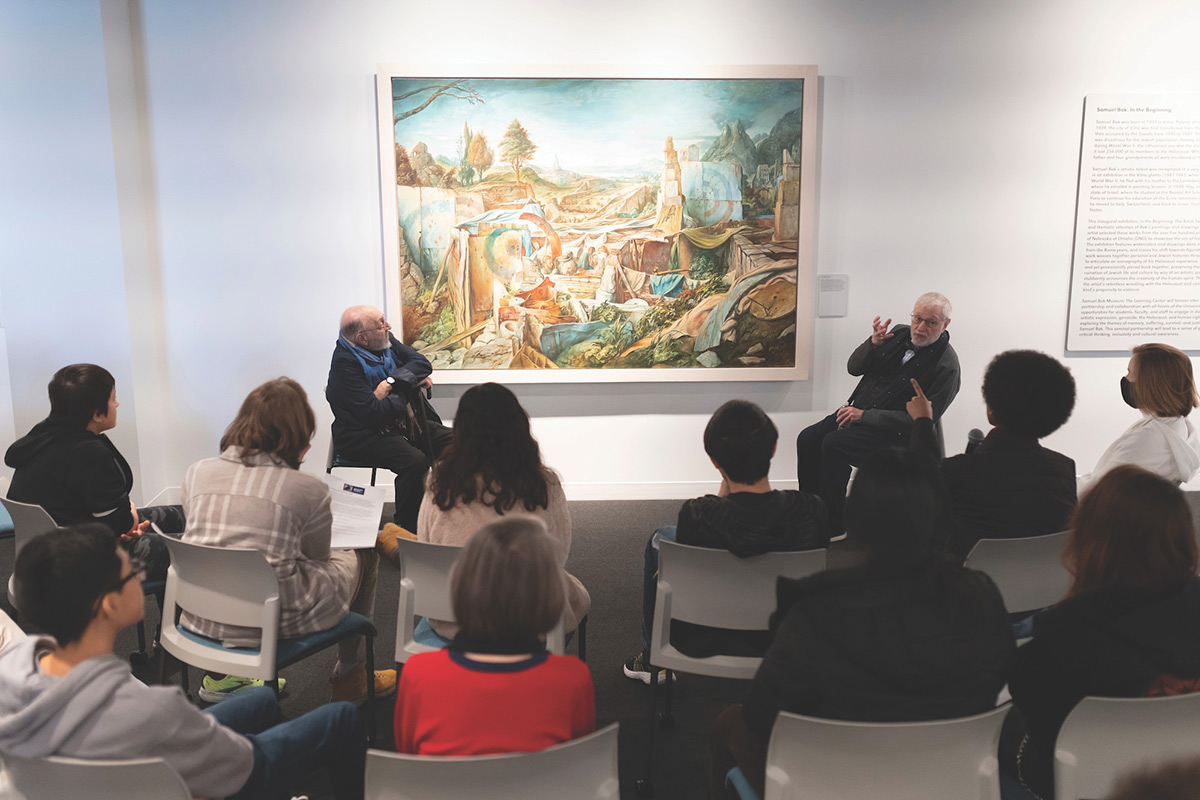
Samuel Bak, left, and Bernie Pucker, whose Pucker Gallery has represented Bak since 1969, talk with students from Buena Vista High School about Bak’s art.
Knowledge of the Holocaust is declining alarmingly. A 2020 survey of adults under 40 showed 63% of those surveyed did not know 6 million Jews were murdered in the Holocaust, and one in 10 did not recall hearing ever hearing the word “Holocaust.” Last year, Nebraska joined two dozen states to require Holocaust education in public schools. Nather-Detisch believes the museum can offer tools for educators to begin the discussion.
Samuel Bak Museum: The Learning Center is free to the public. All ages are welcome.
Visit bak.unomaha.edu for building hours, additional information, and upcoming events.
About the UNO Magazine
UNO Magazine is the flagship publication of the University of Nebraska at Omaha (UNO) and is published three times a year as a collaborative effort of UNO, the University of Nebraska Foundation, and the UNO Alumni Association.